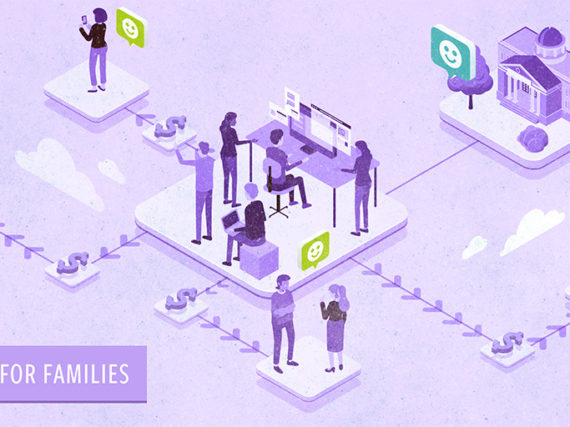Traditionally, the Child Support Enforcement system has been viewed by non-custodial parents (NCPs) as adversarially focused on collection, with punitive measures for default. Recently, the program has been looking to improve outcomes through a more collaborative approach, driven by the latest thinking in behavioral science.
A driving force behind this updated approach is the Behavioral Intervention in Child Support (BICS) grant program from the Office of Child Support of Enforcement. The program gave $13.4 million in grants to eight states to perform behavioral interventions for child support programs in an effort to improve outcomes in compliance and collection.
What do we mean by “behavioral interventions”? In order to understand this we need to first look at the area of behavioral science, and how it applies to child support enforcement.
Why behavioral interventions can help
Across many government programs, rules and policies are based on the belief that participants will always act in the best interest of the program. For example, if you receive a notice to respond to a child support enforcement order, you will always comply in a timely fashion.
The reality, of course, is much different, with many external factors that influence how we respond. These factors are what scientists call “behavioral bottlenecks,” and they tend to fall into three primary categories:
- Choice overload: When faced with too many options, we tend to freeze and make no decision at all. The cereal aisle in the grocery store is one simple example of where too many choices make a decision of what to eat for breakfast harder instead of easier.
- The Ostrich Effect: When faced with bad news we tend to bury our heads rather than confront the issue. That’s why a court summons might stay unopened, rather than being returned.
- Hassle factor: Even simple processes might have friction points that become stumbling blocks for participants. Finding a stamp to mail back a response might be enough to leave paperwork unreturned.
In many ways, the best approach to these issues aligns with a user-centered design process, whereby the program administrators seek to:
- Define the problem
- Diagnose why it is happening
- Speculate on how it can be addressed and design a response
- Test this response
- Refine the response based on feedback to improve outcomes
The following examples detail how the above steps were applied to three states to achieve positive improvements.
BICS examples presented at the APHSA Summit
At this year’s APHSA Summit, Yana Kusayeva, MDRC project manager for the Behavioral Interventions for Child Support Services (BICS) project, assessed the impact of addressing behavioral bottlenecks in three BICS grant programs.
Texas: First month payments
First, in the state of Texas, the focus was on increasing first month payments on new support orders. Researchers found that early compliance led to ongoing compliance, whereas early default typically meant long-term problems in meeting payment obligations. It was determined that many new NCPs weren’t fully aware of their obligations, and would miss initial payments while awaiting direction or for wage garnishment to take effect.
The Texas administration focused on personalizing and simplifying their communication to NCPs and encouraging them to attend one-on-one intervention meetings to review payment options and set up an appropriate plan. They also included follow up calls to ensure full understanding and ongoing compliance.
As a result of these changes, Texas was able to increase first month payments by 5%, which sets the stage for ongoing participation by NCPs.
Georgia: Early engagement
The state of Georgia also focused on early engagement with NCPs by building a collaborative relationship in which parents act voluntarily rather than under duress. Again the emphasis was on simplified, less bureaucratic communication, which emphasized the benefits of participation (in particular the idea of having a voice in the enforcement of orders), as well as the potential penalties from non-action (loss aversion). Prompts included a calendar magnet with the date highlighted to remind NCPs of the child support appointment.
In addition to the improved outreach, case workers were trained in procedural justice concepts which highlight the following goals:
- Be fair in processes
- Be transparent in actions
- Provide opportunity for voice
- Be impartial in decision making
This approach yielded an 8.2% increase in voluntary acceptance of service, with a net increase in cost of just $9.02 per participant. As a result of this three-county trial in Georgia, similar changes are now being rolled out statewide.
California: Simplified communications
Finally, a BICS trial in Sacramento and San Joaquin Counties in California focused on improving communication with NCPs that were previously being served by a 41-page support order as the first notification of their child support obligations. As you can imagine, this experience created cognitive overload for many recipients, particularly for those with English as a second language.
Once again, the focus was on simplifying and personalizing the mailed communication, in order to clearly define the desired action steps. This was backed up with a series of follow up phone calls to try and intervene before the NCP could default on the order.
Overall the California trial saw a 3.1% increase in responses as a result of the changes, but amongst Spanish speakers the response rate was over 20%. The trial also reported on average $93 more in first year payments among participants. These results have convinced the state’s child support enforcement agency to roll out the changes to all counties.
In summary
Although not always yielding dramatic results, it’s clear that these low-cost behavioral interventions can move the needle of NCP participation in child support plans. Furthermore, beyond the increased participation, the changes in approach establish a much more collaborative relationship with NCPs, increasing the likelihood that they will be consistent support payers.
Learn more
- Solutions for Children and Families: Experts at the APHSA Summit discuss how to make changes based on behavioral science
- Working For Families: How child support agencies are supporting employment to yield better returns, by Tom Lovering
- Contact us if you want to learn more about options for child support systems
Author bio
Tom Lovering is the Director of Client Engagement at GovWebworks, and has worked for the parent company, Portland Webworks, since 2008.







